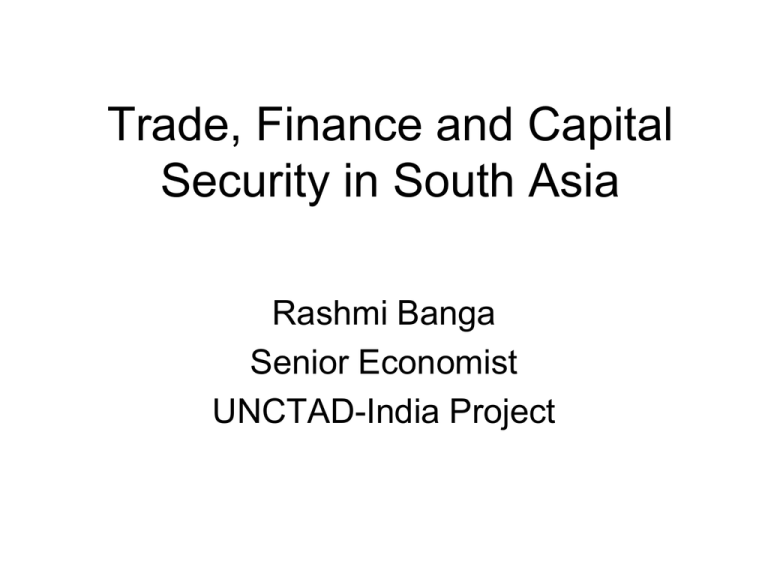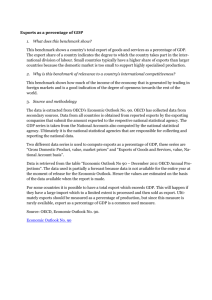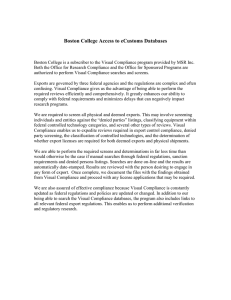Trade, Finance and Capital Security in South Asia Rashmi Banga Senior Economist
advertisement

Trade, Finance and Capital Security in South Asia Rashmi Banga Senior Economist UNCTAD-India Project Global Slowdown Triggered • Due to increased integration of the world markets, transmission of economic crisis from one country to the rest of the world has become easier. • The larger the country, where the crisis originates, the greater is the impact on other countries. • US, one of the largest economy in the world, both in terms of its share in world GDP (27%) and global imports (17%) experienced the sub-prime mortgage collapse in August 2007. • From the financial sector, the crisis creeped into the real sector of countries around the world through different channels. • One of the most important channel through which the financial crisis erupting in US and in other advanced countries has been transmitted to developing countries is international trade. Transmission of Impact Globally: Channels Bilateral trade declines as demand slows down “Echo effect” or third country effect Supply Chain Effects Contraction in trade finances Other Channels of Transmission Portfolio Flows decline Foreign Direct Investment decline Credit squeeze-risk-averse banks cut lending Remittances-income transfers decline Snapshot of the World Economy Real GDP (% change) 2006 2007 2008 2009P 2010P United States 2.80 2.00 1.10 -4.00 0.00 Euro Area 3.00 2.60 0.70 -4.10 -0.30 Canada 3.10 2.70 0.50 -3.00 0.30 United Kingdom 2.80 3.00 0.70 -3.70 -0.20 Japan 2.00 2.40 -0.60 -6.60 -0.50 India 9.70 9.00 6.00 4.30 5.80 China 11.60 13.00 9.00 6.30 8.50 Impact on South Asia: Growth in South Asia : Decelerated in 2008, falling from 8% in 2007 to 5.6 %. Projected to decline to 3.7 % in 2009, before recovering to 6 % in 2010 (World Bank: Feb 09) South Asia: Projections for Real GDP Growth (annual %) by GEP, 2009 Forecast 2005 6.0 2006 6.6 2007 6.4 2008 6.2 India 9.2 9.7 9.0 6.3 5.8 7.7 Nepal 3.1 3.7 2.6 5.5 3.8 4.9 Pakistan 7.7 6.2 6.0 6.0 3.0 4.5 Sri Lanka 6.0 7.7 6.8 6.3 4.0 5.5 Bangladesh 2009 2010 5.7 6.2 Changes in Exports - by developing countries regions in 2008 (USD monthly percentage change with respect of the same month of 2007) 80% 60% 40% 20% 0% -20% 2008m1 2008m2 2008m3 2008m4 Latin America 2008m5 East Asia 2008m6 South Asia 2008m7 2008m8 East Europe and Central Asia 2008m9 2008m10 2008m11 Africa Source: UNCTAD calculations based on data from Datastream, Global Trade Atlas,. • Pakistan suffered the most rapid deterioration in the current account balance, which turned from a surplus of around 4 percent of GDP in 2003 to a deficit of over 8 percent in 2008. • Sri Lanka similarly registered a sharp increase in current account deficit. Even in India, the current account widened sharply from a surplus of more than 2 percent of GDP in 2004 to a deficit of over 3 percent in 2008. • The current balance in Nepal that was in surplus for a fairly long period finally turned into a deficit in 2008. • Only Bangladesh continued to enjoy a surplus in its current balance. Drying up of Trade Finance for Developing Countries • Around 90 percent of total international trade transactions involve credit. • Obtaining such finance has become scarce and costly, the bond market and syndicated loans are effectively nonexistent, while customers are seeking longer repayment periods. • Interest rates on export credits are climbing far above bank refinancing rates; • Survey-based data point to a trade finance gap in developing countries of between US$100 billion and US$300 billion on an annual basis (UNCTAD 2009) • According to the IMF, trade financing of low-income countries dropped by 18 per cent in the fourth quarter of 2008. • Supply chain operations are also being disrupted by lack of financing for developing country suppliers, particularly in Asia. Commodity group Peak in 2008* Jan 2009* % change All commodities (excluding crude petroleum) 299.5 189.4 -37 Food 280.6 196.5 -30 Tropical beverages 193.5 165.5 -15 Vegetable oilseeds and oils 370.5 191.7 -48 Agricultural raw materials 228.6 145.6 -36 Minerals, ores and metals 391.6 203.5 -48 Crude petroleum 469.5 155.6 -67 • • Source: UNCTAD(2009) The long and steep commodity price boom peaked in middle of 2008, prices then fell until the middle of the year and since then have leveled off. • The contraction of demand and deterioration of suppliers’ financial positions contributed to the fall in commodity prices leading to further fall in production and demand. Trade in Services • Travel and tourism-hard hit in South Asia • Export of ICT services declining • Other services exports mainly affected are-construction services, maritime services and financial services International tourist arrivals (UNWTO) • According to the United Nations World Tourism Organization Barometer, international tourism is expected to stagnate at the least if not decline in 2009. They estimate the growth to be in the range of -2% to 0% in 2009 from an average growth of 7% between 2004 and 2007. • In the last six months of 2008, tourist arrivals in South Asia grew by 4% in 2008 as compared to 9.8% in 2007. Foreign Direct Investment (FDI) is sharply decreasing in developing countries • Tighter credit conditions and lower corporate profits have weakened companies’ capability to finance their overseas projects; • while the global economic recession and a heightened appreciation of risk have eroded business confidence. In South Asia-FDI is Resilient • FDI inflows in 2008 to East Asia, South-East Asia and South Asia amounted to $181 billion, $60 billion and $49 billion, respectively (UNCTAD) • For South Asia, FDI has increased by 40% as compared to 2007, while declined by 14% in South East Asia. • In 2009, FDI inflows do not seem to have declined (till March 2009); mainly because of India. • But FDI rose in 2008 as compared to 2007 in – Pakistan, Bangladesh and Sri Lanka. Flow of Remittances UNCTAD-India Study Identification of Vulnerable Sectors in terms of exports and employment Suggest Mitigating Strategies India: Case Study • Heavy reliance of India on US and other Developed countries for its exports • In 2007, around 17% of India’s exports sought US markets, while 29% were directed to G7 countries and around 58% of the exports were directed towards advanced countries 60.0 Figure: India's Export Growth: Quaterly Comparisons 40.0 20.0 0.0 -20.0 -40.0 2005-06 2006-07 2007-08 2008-09 Apr-June 34.5 23.6 20.5 37.4 Jul-Sep 32.4 30.8 19.2 25.6 Oct-Dec 22.5 20.5 33.0 -13.5 Jan-Mar 10.8 16.4 41.9 -27.7 Apr-June Jul-Sep Oct-Dec Jan-Mar Although India is expected to grow, India has not been able to remain insulated. The impact was strongly felt in Oct-Dec 2008-09 and became stronger in Jan-March 2009. Main Objectives of the Study on India • Forecast the impact of slowdown in global GDP on India’s total merchandise exports. • Sectoral forecasts of export growth in ten major sectors of India. • Impact of changed export growth on sectoral employment and total employment • Mitigating strategies in terms of “new products” and “new markets” • Potential exportable products and markets have also been identified Forecast Impact on Export Growth: Methodology The global income demand elasticities for India’s total exports and sectoral exports are estimated. This shows if global incomes rise/decline by 1% how much will the demand for India’s exports rise/decline. Price elasticities for India’s total exports and sectoral exports have been estimated. This indicates the price sensitivity of exports. Econometric Model Estimated • India's Real Export Growth = α1 + α2 Growth in Real GDP of World + α3 (Real Exchange Rate*relative prices) + ut • α2 -are estimated Income Elasticities • α3 -are estimated Price Elasticities • Using the forecasted change in GDP growthtotal and sectoral export growth is estimated. Data Sources • Relative prices are proxied by ratio of world GDP deflators and India’s GDP deflator. • The data for world GDP at current and constant prices is taken from World Development Indicators; • Real exports are arrived at by deflating nominal exports with export unit value index (source: Reserve Bank of India). • Exchange rate is taken from ERS International Macroeconomic Data Set; and India’s merchandise export is taken from World Integrated Solutions (WITS; COMTRADE). • Standard Stationarity tests have been conducted Income Elasticity and Price Elasticity • Income elasticity of India’s exports is found to be very high..1.88 • A 1% rise/fall in global GDP growth will lead to around 2 percentage points increase/decrease in India’s Export growth. • India’s Exports are not very sensitive to price changes.. (-0.54) • therefore lowering of prices may not be an effective strategy. • However sectors-specific differences are prominent Results with respect to Price and Income Elasticities Price Elasticity Income Elasticity 1 Textiles and Textile Products -0.29* 1.16* 2 Ore & minerals -1.27* 4.85* 3 Leather and Leather products -0.88* 1.25* 4 Marine Products -0.47* 1.26* 5 Plantation -1.05* 0.33* 6 Chemicals Chemical products -0.23 2.55* 7 Petroleum products -1.30 5.40* 8 Engineering and Electronic -0.56* 2.28* 9 Agriculture and allied Products -0.71* 1.38* -0.92* 4.11* -0.54* 1.88* 10 Gems & Jewellery Total export Estimating Export Growth using Income Elasticities Estimated Impact of Global Slowdown on India’s Exports • According to the projections, global GDP growth is expected to decline from 2.2% in 2008 to -2.7% in 2009 but it is expected to revive in 2010 to 2.1%. • The results show that there will be a flat export growth in 2009-10, tending towards marginally negative (-2.2%) • However, in line with forecasted global recovery in some of the developed countries, India's exports are estimated to grow at 8.3% in 2010. Export Export growth in Growth 2007-08 2008-09 over 200708 Export Growth 2009-10 over 2008-09 Projected Export Growth 2010 over 2009 Textiles & Products 15.7 -8.9 -3.6 4.6 Ore & minerals 30.4 -12.3 -4.9 26.6 Leather & products 16.3 2.5 -1.6 5.7 Marine Products -2.6 -4.4 -0.1 5.3 Agriculture 55.6 2.6 1.5 14.6 Plantation 11.6 54.6 14.2 14.3 Engineering 26.6 22.0 0.4 9.5 9.7 -4.3 8.1 Chemicals &Products 21.5 Gems & jewellery 23.3 -4.9 -11.1 15.3 Petroleum products 52.0 4.7 -11.8 21.2 Total sectors 29.1 3.40 -2.2 8.3 Estimating Impact on Employment Impact on Employment-2009-10 and 2010-11: Methodology • latest available input-output matrix for India for the years 2003-04 is used. • Using the actual sector-wise exports for the years 2006-07 and 2007-08 (provided by RBI); the inverse matrix and the labour coefficients- total employment change in employment for ten major sectors has been estimated. Impact of Global Slowdown on Employment in India: Results Estimated Job Losses in 2008-09 is 1.16 million, but the net employment created by exports is estimated to be 1.25 million. In 2009-10, projected export growth was 2.2%, total job losses are estimate to be 1.32 million and net job loss of 0.7 million. In 2010-2011, projected export growth is 8.3% and net employment created is 5.22 million. Strategies for Building Resilience of the Economy to Trade Shocks Key Areas for Mitigating Strategies • (a) diversification of exports to new geographical destinations and new products; • (b) simplification in customs procedures for reducing transaction costs; • (c) examination of the likely impact of antidumping and safeguard duties imposed by India on down-stream user industries; • (d) measures aimed at assisting exporters to retain their market presence during the crisis period; and • (e) expeditious multilateral examination of adverse impact of bailouts and stimulus packages and prompt remedies. “New products”- “New Markets” • A detailed analysis at six digit level of India’s competitiveness in markets of developing countries is undertaken to identify “new products” and “new markets” • 958 products have been identified in developing countries markets. • It is estimated that with this diversification, India has the potential to increase its exports of new and potential products by almost 21% (USD 35 billion) Strategies to build Resilience of the Region “Look within” to Boost Regional Trade and Investment • Need to give fresh push for ‘full implementation of SAFTA’ with substantially reduced negative lists. • Formation of possible “Regional Supply Chains”to boost intra-regional investments-UNCTADIndia Study • Encouraging BITs within the region and interregional Investment Agreements “Regional Voice” against Protectionism • Regional effort is required against the protectionist policies of some of the developed countries-Especially trade under mode 4. • Impact of bail-out packages on region’s exports and export of individual countries in the region needs to be carefully monitored. Partnership for Development • Regional stand to start implementation of “duty-free, quota-free” treatment for exports of LDCs in 2009. • Assurance by developed countries to keep their GSP schemes free of new restrictions and conditions. • Regional support for trade financing should be encouraged e.g., South Asian Development Bank for SARRC countries. • Close mutual financial cooperation through SAARC finance (1998). Future Growth Poles • For the region to emerge stronger in future it is important to identify areas and sectors that may become future growth poles, e.g., different forms of sustainable agriculture (including organic) and resource-efficient products, like solar energy using products, etc. • Investing in human resources and skill development. Research Directions • Detailed Country-specific and region-wise studies on identification of vulnerable sectors is required. • Research on identifying trade and investment supply chains. • Involving industry groups in consultations for disseminating research on regional opportunities • Policy advocacy required for boosting regional efforts Thank You






